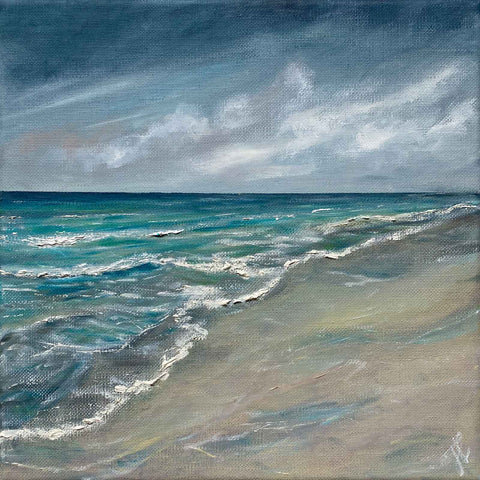Dreaming of a long walk on a sandy beach
Share
Seascapes 52: week 18
Do you share my love of strolling along a sandy beach? This week's Seascapes 52 is all about the beautiful beach on the island of Sol and shares some tips for composition.

This Cabo Verde beach scene is one of my newest seascapes. I began painting it in early January (of this year, so not a looooong project like the one shared in last week's blog). There is a parallel between the start of this blog series and the commencement of this painting. The rationale underlying Seascapes 52 is to deepen my reflections on practice to evolve my work. So the painting itself brings together some of the things I was hoping to reflect on in the blog series.
For example, reflecting on which seascapes are my favourites, brings to light what sort of compositions I prefer. The composition here is partly inspired from a reference photo I took on holiday some years ago. Yet, I've recropped the image to get a different angle and composition from my original photograph. At the time of taking the shot, I was primarily keen to simply capture the sense of space that I love about being at the coast. More recently, I'm seeking to create more visual interest in my compositions. The new composition aims to accentuate the sense of walking into painting between the dunes and the shoreline, while not losing the expansiveness of the scene.
In this respect, the diagonal plays a key role. As a design geek, I know that diagonals add drama and movement to a composition. So some of my most serene seascapes tend to be fairly horizontal in their composition. Tipple is an example of this kind of stable horizontal composition:

Tipple, oil on canvas, 2022
It's not too static though, because the diagonals of the clouds create some movement in the sky. And, of course, there's the texture of the surf to add movement to the sea.
In Cabo Verde, the diagonals of the shoreline and dune ripples enhance the sense of movement and depth. They create that feeling of walking along the beach. However, the movement is still tranquil. The undulating curves of the waves and sand soften the diagonal. So, you get a sense of serenity and calm, while not losing the movement into the picture plane.
The sense of space and movement is also deliberately constructed through compositional devices like using particular ratios when planning the painting. Cabo Verde is roughly one third sky and two thirds earth. If the horizon fell in the middle of the painting, the mirroring proportions of sea and sand could be very static. However, if the sky was too small, the sense of space would also be lost.
It's also important to consider your decisions about format. Most of my seascapes are in landscape orientation because this helps create that sense of space and movement. It's easier to lead the eye through a wide composition than a square composition. So in my trio of small square seascapes (middle one has sold, btw and thank you to the lovely young lady who chose to take it home with her), the movement is accentuated by stronger diagonals and textures.

Talking of squares, visitors to the Otley Coffee Culture festival last weekend enjoyed a sneak preview of another Cape Verde creation. It's part of a new trio. More about these 3 seascape paintings soon. In the meantime here's a wee glimpse for you:

If you fancy a seaspape on your walls so that you dream about strolling along a beautiful sandy beach, you can find most of these and a few more in my Land & Sea collection. I'll also be sharing some larger ones at an upcoming exhibition at the Otley Courthourse opening in the last week of May.
Thanks for reading. Next Wednesday we'll blog on with Seascapes 52.